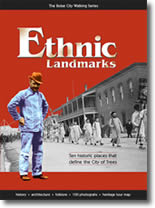Get out of your car, grab guidebook and really see Boise, historian says – ‘ Ethnic Landmarks ‘ features 10 spots in Boise where immigrants left their mark
Idaho Statesman, The (Boise, ID) – Friday, January 26, 2007
Author: ANNE WALLACE ALLEN, Staff

Todd Shallat, the city historian, would like more people to tour Downtown Boise the way he does: from the ground up.
Shallat walks Boise’s city center instead of driving whenever possible. And he’s encouraging others to do so, as well, to appreciate the small vestiges of Boise’s past that are hidden in the alleys or painted in fading ink on the city’s buildings.
“There’s nothing more basic and nothing more green than cruising through your neighborhood at three miles an hour on your feet,” Shallat said. “It’s not only good for your lungs — it’s good for your community.”
With this concept in mind, Shallat has written a guidebook for City Hall called ” Ethnic Landmarks ,” the first in a series aimed at showing people around the city at a walk.
When Boise was a young city, he notes, almost nobody drove.
“Walking shaped the way people interacted, and it created a city of ethnic enclaves that have been depleted today,” Shallat said.
” Ethnic Landmarks ” features ten spots in Boise where immigrants left their mark — such as the Star Hotel, a Basque boardinghouse from 1903 to 1975, and O’Farrell’s Cabin, a one-room cottonwood structure that was the site of Boise’s first Catholic Mass. A section on Chinatown shows a 1908 parade of Chinese residents with a large cloth dragon on 7th Street. Only a few buildings from the old Chinatown survive today.
The walking guidebook series one day will include books on Rose Hill, Warm Springs, South Boise and the North End.
Through encouraging Boise residents to take a closer look at their neighborhoods, city leaders hope to educate them as Boise planners manage the city’s enormous population growth. They’re looking for ways to integrate automobiles and pedestrians into the landscape and to create neighborhoods where residents are diverse in age, income and background.
The point “is not to get rid of the auto, but to open up as many ways of transit through the city as possible,” Shallat said. “Walking, biking, mass transit, walking through alleys.”
How you get around really does make a difference in how you see the city, said Rich Harris, who owns the Downtown store Bandanna Running and Walking. Harris rides his bike to work every day and sees more of Boise that way, he said.
“I don’t always take the same way to work; I’ll go down a different block just to see what’s going on,” he said. “You could never do that in a car.”
If residents walk, businesses that cater to pedestrians will follow, Shallat said. Those businesses might include a corner store that sells a gallon of milk.
By creating this place, Boise can avoid the fate of places that have been ruined by sprawl and have made walking impossible, Shallat said.
“I’m a child of the suburbs; it was dreadful,” said Shallat, who grew up in California. “The only place we got together and congregated was the parking lot in front of the liquor store.”
Shallat, a history teacher who is director of the Center for Idaho History and Politics at Boise State University, takes his BSU students on walking tours of the city’s alleys to see the backs of the old buildings, some of them still bearing painted-on signs from almost a century ago. He wants to make sure students don’t take those aspects of the city for granted.
“All the qualities that make Boise unique — the river, the rim, the Foothills, the train depot, its North End, its tree-lined streets … I would like to see those things preserved,” Shallat said.
” Ethnic Landmarks ” is available at the mayor’s office for $10 or at local bookstores such as Trip Taylor Bookseller on 10th Street.